#intergovernmental deliberation
Text
One simple way to look at it is to take the rate of emissions reductions achieved in countries that have successfully decoupled, and see how long it would take for them to fully decarbonize. That’s essentially what Jefim Vogel and Jason Hickel — researchers at the University of Leeds and the Autonomous University of Barcelona, respectively — did in the Lancet Planetary Health study. They found that, if 11 high-income countries continued their achieved rates of emissions reduction, it would take them more than 220 years to cut emissions by 95 percent — far longer than the net-zero-by-2050 timeline called for by climate experts.
“The decoupling rates achieved in high-income countries are inadequate for meeting the climate and equity commitments of the Paris Agreement and cannot legitimately be considered green,” the authors wrote. In an interview with Grist, Vogel likened optimism around gradual decoupling to saying, “Don’t worry, we’re slowing down,” while the Titanic races toward an iceberg.
[...]
“Absolute decoupling is not sufficient to avoid consuming the remaining CO2 emission budget under the global warming limit of 1.5 degrees C or 2 degrees C and to avoid climate breakdown,” concluded the Intergovernmental Panel on Climate Change in its most recent assessment.
Instead of making growth greener, some economists call for a whole new economic paradigm to address converging social and ecological crises. They call it “post-growth,” referring to a reorientation away from GDP growth and toward other metrics, like human well-being and ecological sustainability. Essentially, they want to prioritize people and the planet and not care so much what the stock market is doing. This would more or less free countries from the decoupling dilemma, since it eliminates the growth imperative altogether.
Raworth, the professor at Amsterdam University of Applied Sciences, calls her version of the post-growth agenda “doughnut economics.” In this visual model, the inner ring of the doughnut represents the minimum amount of economic activity needed to satisfy basic needs like access to food, water, and shelter. The outer ring signifies the upper limits of natural resource use that the Earth can sustain. The goal, she argues, is for economies to exist between the inner and outer rings of the doughnut, maintaining adequate living standards without surpassing planetary limits.
“Our economies need to bring us into the doughnut,” Raworth told Grist. “Whether GDP grows needs to be a secondary concern.”
Vogel and Hickel go a little further. They call for a planned, deliberate reduction of carbon- or energy-intensive production and consumption in high-income countries, a concept known as “degrowth.” The rationale is that much of the energy and resources used in high-income countries goes toward carbon-intensive products that don’t contribute to human welfare, like industrial meat and dairy, fast fashion, weapons, and private jets. Tamping down this “less necessary” consumption could slash greenhouse gas emissions, while lower energy demand could make it more feasible to build and maintain enough energy infrastructure. Some research suggests that reducing energy demand could limit global warming to 1.5 degrees C without relying on unproven technologies to draw carbon out of the atmosphere.
75 notes
·
View notes
Text




























International Tea Day
While everyone loves a cup of tea, many of the workers and producers of that tea face poor conditions and pay. Help raise awareness and keep tea fair.
The tea industry provides millions of people around the world with cups of tea in the morning. One of the biggest producers of tea, India, recognizes the importance of tea in its communities and as a commodity for commerce.
However, much of the working conditions for those within the tea industry still need much improvement. If you think this holiday was about drinking tea, well think again! International Tea Day is all about the tea workers and bringing civil rights into action. Let’s see how this holiday came to pass.
Do you love a good cup of tea? While International Tea Day can certainly involve paying homage to tea, we should pay homage to those working in the tea industry. The best way to do this is by helping to raise awareness regarding their working conditions so they can be improved.
History of International Tea Day
The International Tea Day campaign was launched in 2005 by the trade unions, small tea growers and civil society organizations in Asia and Africa to address the issues of living wages for workers and fair prices for small tea producers.
The International Tea Conference in New Delhi came out with an International Declaration on the rights of workers and small growers to help regulate uneven competition, land ownership, safety regulations, rights of women, social security and living wages. Another organization, The Tea Board of India, proposed International Tea Day in hopes of it becoming an official holiday to the UN Food and Agriculture Organization.
This was proposed by chairman Santosh Kumar Sarangi in 2015. According to the chairman, the proposal of India was supported by countries such as Canada, the United States, European Union, Sri Lanka, China, Japan, Kenya, and Malawi. While the holiday doesn’t have official status, the goal of this holiday is to recognize the vulnerable situations that tea producers in India have with current living conditions and worker-related policies.
The day also focuses on deliberating on urgent issues such as residues, climate change, technology and trends on production and consumption in the tea industry. To observe this day, over 150 representatives from tea organizations gather and conduct a seminar to discuss the pervading problems the tea industry has as well as problems faced within their own country.
International Tea Day Timeline
2737 BC Tea is discovered as a beverage
Legend has it that Chinese Emperor Shen Nung is sitting beneath a tea tree while a servant boiled water for drinking. Some leaves fall into the cup and begin the practice of drinking what is now called “tea”.
1610 Tea comes to Europe
It is believed that the Dutch were the first to bring tea to Europe, just a few years prior to the introduction of coffee by Venetians.
1773 The Boston Tea Party occurs
With the intention of revolting against the high taxes levied by the British government without providing any voice, residents of Massachusetts throw tea into the Boston Harbor. “No taxation without representation” is the major complaint.
2004 International Tea Day is created
At the World Social Forum, International Tea Day is conceived and then celebrated the following years in New Delhi and Sri Lanka, then later in other tea-producing places like Nepal, Viet Nam, Bangladesh and others.
2019 United Nations adopts International Tea Day
After some years of advocating for its observance, International Tea Day is adopted by the United Nations General Assembly at the suggestion of the FAO Intergovernmental Group on Tea.
How to Celebrate International Tea Day
If you’re a lover of tea, then do some research about some of your favorite companies. Try looking up tea brands that support fair trade, and possibly switch to those brands to make a difference in the way you buy products such as tea. Use the hashtag #internationalteaday to help recognize it as an official holiday and educate others about the tea industry if you’re interested.
You could also use International Tea Day to try a variety of tea you have never had before. Matcha, for example, is highly popular as of late. You need to shop with care, though! The first thing you need to take a look at is how the Matcha has been produced and sourced.
You need to ensure that all veins and stalks have been removed so that there is not any bitterness and only the finest leaves should be used. Secondly, the color of the matcha powder is a significant factor. The greener the color is, the better. This is because the leaves are forced to overproduce chlorophyll because Matcha is shade-grown, which causes the vibrant green shade.
If the Matcha is yellow or brown in color, this is a sign that the leaves have not been properly shaded or that branches and stalks have been included. The price is the third factor to consider. Like most things, if you want quality, you can expect to pay a little bit more.
If something seems too good to be true, the chances are that it is. The feel of Matcha is also important. It should be a fine powder that is very silky. Last but not least, the taste is obviously a crucial attribute when it comes to quality. It should have a clean and naturally sweet taste.
Why not make some delicious baked green tea treats on International Tea Day and have a bake sale to raise money and awareness regarding working conditions in the tea industry? Green tea recipes are available in their abundance. People are actively searching for different ways to enjoy green tea. While green tea is delicious when simply mixed with hot water, there is nothing wrong with switching it up from time to time, especially on International Tea Day!
An easy and delicious recipe is Matcha Meringue Kisses. To make this you will need Matcha, sugar, egg whites, and powdered sugar. Begin by sifting together the Matcha and the powder sugar, and then whip the egg whites until they have soft peaks. Gradually add the sugar and whip until stiff peaks. Gently fold the Matcha into this mixture and then transfer to a pastry bag. Pipe the mixture into small kisses onto a baking tray and then bake for around an hour.
Or, why not make Green Tea Donuts? For this, you need green tea, honey, melted butter, milk, egg, salt, baking powder, sugar, and cake flour. You whisk the green tea, salt, baking powder, sugar, and flour. Add the honey, melted butter, milk, and egg, and then whisk. Use a pastry bag to pipe the batter into the mould. Then, simply bake the donuts for eight minutes. You can make your own glaze to go on the top – chocolate goes well!
Other delicious baked treats to try include green tea muffins, brownies and shortbread!
International Tea Day FAQs
What is International Tea Day?
Created to celebrate and pay tribute to the countries that produce tea to supply to the world, starting in India and moving to other places like Sri Lanka, Malawi, Uganda, Bangladesh, Vietnam and more.
When was International Tea Day first celebrated?
International Tea Day first got its start in 2004 when it was celebrated in New Delhi. It grew over the years and by 2019 the day was adopted by the United Nations General Assembly.
How to celebrate International Tea Day?
A great way to observe this day is by learning a bit more about the nations who produce tea for the world. Also, don’t forget to order a cup of fair trade tea for one, or take a friend out to enjoy a cuppa together.
What is the theme of International Tea Day?
The theme for this day devoted to tea producers changes each year, but some of the past themes have included themes such as Tea and Fair Trade or Harnessing Benefits for All from Field to Cup.
When is International Tea Day celebrated?
Taking place on May 21 of each year, International Tea Day originally took place on December 15 from 2005 when it was often only celebrated by tea-producing countries. It changed to May 21 when the UN adopted the day.
Source
#Earl Grey#Earl Grey Tea is my favorite tea#Computer tea Earl Grey hot#USA#I don't like coffee#I only drink tea#original photography#always unsweetened#Lemon Black Tea Lemonade#Tropical Ice Tea#Peach Green Tea#Lavender Ice Tea#Pineapple Black Tea#Strawberry White Tea#Peach Citrus Green Tea#International Tea Day#21 May#InternationalTeaDay#travel#vacation#Capilé#Portugal#Women are Persons By Barbara Patterson#Tea Earl Grey Hot#Spiked Texas Tea#Lemon Black Tea
2 notes
·
View notes
Text
Multi-stakeholder round table 2: International trade as an engine for development.
The Fourth International Conference on Financing for Development (FfD) will take place from 30 June to 3 July 2025 in Spain. The Conference will result both in an intergovernmentally negotiated and agreed outcome and in summaries of the plenary meetings and other deliberations of the Conference, to be included in the report of the Conference. The UN Department of Economic and Social Affairs (DESA), through its Financing for Sustainable Development Office, and the UN Economic and Social Council (ECOSOC) will support the Conference and its preparatory process.
Permanent Representative of Burundi Zéphyrin Maniratanga and Permanent Representative of Portugal Ana Paula Zacarias will co-chair the Committee. The Vice-Chairs of the Preparatory Committee are South Africa, Zambia, Iran, Nepal, Pakistan, Poland, the Russian Federation, Brazil, Colombia, Mexico, Canada, and Norway. China will serve as a Vice-Chair on a rotational basis with the other elected Asia-Pacific States.
The Preparatory Committee will hold two meetings in 2024 and a third session in February 2025. The Committee will also convene a one-day stakeholder hearing in October 2024.
Watch the Multi-stakeholder round table 2: International trade as an engine for development!

#trade#un trade & Development#unctad#ecosoc#united nations economic and social council (ecosoc)#united nations department of economic and social affairs (desa)#unhq#preparatory committee#4th international conference on financing for development#plenary meeting#round table
0 notes
Text
The Role of the Port Orange,FL City Council and Local Government
Navigating Governance: The Role of the Port Orange, FL City Council and Local GovernmentIntroduction:In the intricate tapestry of civic life, local government serves as the linchpin connecting communities with essential services, infrastructure, and decision-making processes. For More Information
Port Orange, Florida, nestled along the Sunshine State's eastern coast, exemplifies the significance of effective municipal governance. At its helm lies the Port Orange City Council, steering the city towards progress, prosperity, and sustainable development.
Representation and Decision Making:The Port Orange City Council stands as the epitome of local democracy, comprising elected representatives entrusted with safeguarding the interests of the city's residents. This governing body operates within a framework designed to ensure accountability, transparency, and responsiveness to the needs of the community.
Through regular meetings, public hearings, and engagement initiatives, the council facilitates an open dialogue between citizens and policymakers, fostering a culture of participatory governance.
Policy Formulation and Implementation:At the core of its responsibilities, the Port Orange City Council plays a pivotal role in shaping the city's policies and ordinances. Drawing upon the expertise of city staff, advisory boards, and community input, council members deliberate on matters ranging from zoning regulations to budget allocations.
By leveraging their collective wisdom and strategic vision, they craft solutions tailored to address the evolving needs and aspirations of Port Orange residents. Once approved, these policies are meticulously implemented, ensuring their effective execution and enforcement.
Fiscal Stewardship and Budgetary Oversight:Sound financial management lies at the heart of municipal governance, and the Port Orange City Council assumes a central role in overseeing the city's fiscal affairs. Through the annual budgetary process, council members allocate resources judiciously, balancing the competing demands of various departments and programs.
By prioritizing investments in infrastructure, public safety, and quality of life initiatives, they strive to enhance the city's economic resilience and long-term sustainability. Moreover, the council exercises prudent oversight to safeguard taxpayer dollars, promoting transparency and accountability in all financial transactions.
Community Engagement and Outreach:Beyond its legislative and administrative functions, the Port Orange City Council fosters a culture of civic engagement and community empowerment.
Through town hall meetings, neighborhood forums, and online platforms, council members solicit feedback, address concerns, and cultivate partnerships with local stakeholders. By actively involving residents in the decision-making process, they harness the collective wisdom and diverse perspectives needed to tackle complex challenges and foster inclusive growth.
Collaboration and Regional Cooperation:Recognizing the interconnectedness of regional issues, the Port Orange City Council advocates for collaboration and cooperation with neighboring municipalities, county governments, and regional entities. By participating in intergovernmental forums, task forces, and joint initiatives, council members seek to address shared challenges, leverage resources, and maximize the collective impact of regional policies and programs.
Through strategic partnerships and alliances, they strive to advance common goals and promote the overall well-being of the greater Port Orange community.Conclusion:In the tapestry of local governance, the Port Orange City Council emerges as a beacon of leadership, stewardship, and community service.
Through its unwavering commitment to public service, the council embodies the principles of democracy, accountability, and civic engagement. By collaborating with residents, businesses, and stakeholders, it charts a course towards a vibrant, resilient, and inclusive future for Port Orange, Florida, ensuring that the city remains a beacon of opportunity and prosperity for generations to come.
0 notes
Text
Latest Updates on Climate Change

Recent scientific findings underscore the urgent need for action. From the retreating ice caps to extreme weather events, the indicators of a warming world are becoming increasingly hard to ignore. This urgency has catalyzed a global conversation that continues to evolve, spurred by breakthroughs in green technology, international policy debates, and a groundswell of public awareness. Drawing insights from key organizations such as the Intergovernmental Panel on Climate Change (IPCC) and the National Oceanic and Atmospheric Administration (NOAA), this article explores the most current information on the climate crisis.
Key Takeaways
Global warming is an urgent problem, with recent data showing an acceleration in the rate at which our planet is heating up.
Major drivers of climate change include CO2 emissions from fossil fuel combustion and deforestation.
International policies and advancements in sustainable technologies are significant in mitigating the environmental impact of climate change.
Data from the IPCC and NOAA are essential for tracking changes in global climate patterns and informing policy decisions.
Increased public awareness is essential for driving the collective action needed to address the climate crisis.
Understanding the Current State of Global Warming
As the world grapples with the escalating signs of climate change, it's vital to note the temperature rise that underscores the severity of the situation. A substantial increase in global average temperatures is driving a cascade of extreme weather events with profound implications for the planet.
The Rising Global Temperature Trends
Data from NASA's Goddard Institute for Space Studies presents an alarming upward trajectory in global temperatures, leading to enhanced occurrences of heatwaves and droughts. This evidence of temperature rise demonstrates the direct implications of elevated greenhouse gases in our atmosphere.
youtube
Recent Anomalies in Weather Patterns
The carbon footprint of human activity is not only heating up the planet but also contributing to erratic weather phenomena. The National Weather Service, among others, observes how hurricanes and wildfires are juxtaposed against the backdrop of a destabilizing climate, indicating a new normal in extreme weather incidents.
Long-Term Climate Predictions and Models
Climate modeling remains at the pinnacle of understanding future impacts, with projections unambiguously showing continued temperature escalation if current emission rates persist. The World Meteorological Organization, together with a network of global scientists, endeavors to sharpen these models to aid policy makers in addressing the urgent need for change.YearGlobal Average Temperature Increase (°C)Notable Weather Event20211.2Heatwave in North America20221.3Severe Flooding in South Asia20231.4Intense Cyclone Season in the Pacific
International Efforts to Combat Climate Change
The conversation around climate change is increasingly dominated by concrete actions taken on the global stage. International agreements and engagements such as the Paris Agreement and the United Nations Framework Convention on Climate Change (UNFCCC) are not just formalities—they represent a collective commitment by nations to tackle the climate crisis head-on. These frameworks set ambitious targets for reducing global emissions with an eye towards achieving carbon neutrality.
Each year, the UN Climate Change Conference acts as a crucible for these commitments, where countries convene to negotiate, deliberate, and ultimately strengthen the resolve for collective action. Here, progress is meticulously assessed against sustainable development goals, which serve as a blueprint for a greener, more sustainable future. Underscoring this international endeavor is the spirit of global cooperation, critical for ensuring equitable climate action across various economic landscapes.
Financial backing, termed as climate finance, also plays a pivotal role, bridging the gap between developed and developing nations. This facilitation ensures that global economic disparities do not become a barrier to environmental stewardship. Moreover, a significant trend in harmonizing international trade and investment with climate goals heralds an era of innovation in renewable energy—an endeavour supported by data and reports from reputable entities like the United Nations Environment Programme (UNEP) and the International Renewable Energy Agency (IRENA). These institutions offer invaluable insights into the challenges and advancements inherent in the global fight against the climate crisis.
Read more:
Step Up Your Hiking Game: Unraveling The Secrets To Finding A Great Pair Of Hiking Boots
Sleep Comfortably On The Road: Unveiling The Best Rv Mattress Sizes For Your Next Adventure
Crack The Code: How To Navigate Through Men’s Product Reviews To Find The Best Quality And Value
0 notes
Text
Troika Nations Unite: Condemning Sudan's Violence

Alarming Reports of Violence and Abuses
Norway, the United Kingdom, and the United States, collectively known as The Troika, strongly condemn the increasing violence and human rights abuses unfolding in Sudan. Of particular concern are the attacks by the Rapid Support Forces (RSF) in West, Central, and South Darfur.
Credible reports highlight disturbing incidents, including mass killings, ethnic targeting of non-Arab communities, violence against traditional leaders, unjust detentions, and hindrances to humanitarian aid. Alarming reports also surface from the town of Jebel Aulia, White Nile River, suggesting the deliberate targeting of civilians.
Denouncing Military Solutions and Urging De-escalation
The Troika underscores the unequivocal stance that a military solution is unacceptable in resolving the conflict. The Troika resolutely calls for an immediate end to the fighting, urging the RSF and Sudanese Armed Forces (SAF) to refrain from actions deepening ethnic divisions or involving additional forces in the conflict.
Both parties are implored to de-escalate tensions and engage in substantive discussions leading to a ceasefire and unrestricted humanitarian access. The recent talks in Jeddah, facilitated by the Kingdom of Saudi Arabia, the United States, and the Intergovernmental Authority on Development (IGAD), offer a glimmer of hope. These talks, inclusive of the African Union, witnessed initial humanitarian commitments by the involved parties on November 7.
Towards a Sustainable Solution
A sustainable solution necessitates halting violence and reinstating a civilian-owned political process to establish a civilian government and restore Sudan's democratic transition. The Troika expresses support for the Sudanese people's tireless efforts in promoting humanitarian responses, advocating an end to the war, and reigniting the stalled political transition.
Troika's Commitment to Sudanese People
Proudly standing as among the largest donors supporting the Sudanese people, the Troika nations reaffirm their commitment. Their focus remains on ensuring diverse communities actively participate in building Sudan's democratic future.
Simultaneously, they pledge support for displaced persons and vulnerable communities through crucial humanitarian aid initiatives. The Troika emphasizes its dedication to fostering a democratic and inclusive Sudanese future.
Sources: THX News & Foreign Commonwealth and Development Office.
Read the full article
#CeasefireCallinSudan#HumanRightsAbusesDenouncement#JeddahTalksHumanitarianCommitments#RSFAttacksinDarfur#SudanViolenceCondemnation#SudaneseDemocraticTransitionSupport#SustainableSolutionforSudan#TroikaNationsJointStatement#Troika'sGlobalHumanitarianSupport#WorldwideAppealforSudanPeace
0 notes
Text
MINNEAPOLIS (AP) — A Minnesota county agreed to pay a $12.2 million settlement to a man who was jailed on suspicion of drunken driving but ended up losing both his hands and suffering a heart attack, a stroke and skin lesions all over his body, allegedly due to the inaction of officials in the county jail, attorneys said Wednesday.Terrance Dwayne Winborn spent about four months in hospitals, including two months on a ventilator, because Scott County jail officials failed during the 39 hours he was incarcerated to ensure he got the prompt treatment he needed, his lawyers said at a news conference.It’s a case that highlights the vulnerability of prisoners who are dependent on authorities for medical care.The attorneys said the settlement will cover the more than $2 million in medical bills Winborn has already incurred — a sum which they said the county didn't cover — as well as the millions he'll need for ongoing care. The county's insurance plan will cover the settlement.“That deliberate indifference allowed a bacterial infection to run rampant within his body, leading to a heart attack ... and a host of other devastating and permanent injuries,” attorney Katie Bennett told reporters.Jason Hiveley, an outside lawyer who handled the case for Scott County, said in a brief statement that the county and its insurer, the Minnesota Counties Intergovernmental Trust, agreed to the settlement in exchange for dismissal of Winborn’s lawsuit and a release from his claims. The statement did not say whether the county still denies any wrongdoing.Winborn's attorneys played a video showing his difficulties in adapting to life without hands, including feeding himself. He said he eats two meals a day because three takes too much work.“I don't sleep because every time I dream, I dream I have my hands, you know. And I wake up, they're gone again," Winborn said in the video. “I'd rather have my hands than anything.”Winborn, from the southwestern Minnesota city of Marshall, was arrested in the Minneapolis suburb of Shakopee in the early hours of Aug. 27, 2020. His blood alcohol content measured 0.13% at the jail, according to the lawsuit he filed last year. The legal limit for driving is 0.08%. Late that morning, after his blood alcohol content returned to zero, he began vomiting.He was unable to stand up that morning when a jail nurse came by for a COVID-19 check, the complaint said. She noted that his right hand was “extremely swollen,” and that he had trouble answering questions. On a second visit, around midday, the nurse was unable to measure his blood oxygen level but still did not attempt to get him emergency care. By the time a corrections officer drove Winborn to a Shakopee hospital the evening of Aug. 28, his condition was even worse.Personnel at the suburban hospital were so concerned that they sent him by ambulance that night to a bigger hospital in Minneapolis, where he was put in intensive care, the complaint said. Doctors amputated his hand and part of his forearm two days later after necrotizing fasciitis set in, a condition popularly known as flesh-eating bacteria. It's a rare condition in which marauding bacteria run rampant through tissue. Affected areas sometimes have to be surgically removed to save the patient’s life.By the time Winborn was transferred to a nursing home that November, his weight had dropped from his normal 180 pounds to 126 pounds (82 kilograms to 57 kilograms). Another infection led doctors to amputate his left arm below the elbow that December.The complaint also said jail videos that could have provided important evidence were destroyed after 90 days because officials took no action to preserve them — despite knowing about the severity of Winborn's injuries and the potential for litigation. Jail officials stated in their depositions that they couldn't remember what happened."The County and MCIT are hopeful the resolution of this matter will help provide Mr. Winborn with the medical care and quality of life assistance he needs,” Hiveley said.
0 notes
Link
[ad_1] After months of deliberations, the federal government will be launching a public inquiry into foreign interference, and have found a judge to lead it, CTV News has confirmed. According to government sources, Quebec Court of Appeal Justice Marie-Josée Hogue will lead the probe, which will look beyond China to other foreign meddling. Minister of Public Safety, Democratic Institutions and Intergovernmental Affairs Dominic LeBlanc is expected to make the announcement about the terms and timeline for the inquiry on Thursday, when he speaks publicly at 11:30 a.m. Sources told CTV News that Hogue will be heading into this effort with the goal of reaching conclusions and recommendations prior to the next federal election, currently scheduled for 2025. This development comes after several months of opposition parties and some national security stakeholders calling for a full public inquiry, amid heightened attention on alleged attempts by China to meddle in the 2019 and 2021 federal elections. Sources specifically pointed to the alleged targeting of certain Conservative ridings in Ontario and B.C. in 2021 as an area Hogue will investigate. The spring decision by then-special rapporteur David Johnston not to recommend an inquiry—citing the inability to satisfy the concerns of Canadians due to the national security limitations on making key details public—drew swift criticism. But on the heels of his resignation, the Liberals showed new openness to a public process and LeBlanc began engaging in negotiations with the other parties on a suitable structure and official to lead the inquiry. Last month, Prime Minister Justin Trudeau insisted that his government would move forward with a “robust inquiry into foreign interference of all different types” despite reported issues locking in someone to lead it. Throughout these deliberations the Liberals have said they wouldn’t be proceeding with an inquiry until there was “full buy-in” from the other parties, an effort to strip out as much of the politics as possible after the government’s first attempt crumbled under partisan scrutiny. As parties have spent the summer discussing next steps, a former RCMP officer has been charged with foreign interference-related offences for allegedly helping China identify and intimidate an individual, and a Canadian monitoring system has detected a likely China-backed "information operation" targeting Conservative MP Michael Chong. The inquiry will look at the wider issue of members of Parliament who say they were targeted, including Chong and others, sources said. Speaking in Singapore, Trudeau said Canada and China’s relationship remains strained, as a result of “real concerns around foreign interference.” Asked about whether news will soon be coming on a foreign agent registry the government has also been consulting on, the prime minister indicated that was a more “complex” file. With files from CTV News’ Annie Bergeron-Oliver and Vassy Kapelos. More details to come. [ad_2]
0 notes
Text
80 percent less plastic pollution is possible by 2040

The UN Environment Program[1] wants to curb global plastic pollution. According to a report, by 2040 such waste in the environment could be reduced by 80 percent. But a lot would have to change in order to reach that goal.
According to a study, global plastic pollution could be reduced by 80 percent by 2040. All resources are already available for this, according to a report by the United Nations Environment Program (UNEP) published on Tuesday.[2]
The prerequisite for this, however, are far-reaching political and market-economy changes towards a circular economy. "Plastic can continue to bring tremendous benefits to humanity, but only if we rethink the systems that keep it circulating in the economy," UNEP Executive Director Inger Andersen said at the launch of the report.
By increasing the reuse of plastic alone, around 30 percent of plastic waste could be avoided by 2040. The report refers, among other things, to the introduction of deposit systems.[3] In addition, according to UNEP, simpler solutions such as using refillable bottles for soap or cleaning products could also reduce the amount of plastic waste.[4]
Switching to a circular economy would be worthwhile
A further 20 percent of plastic waste could be saved through more recycling -provided that such waste recycling becomes more profitable in the coming years. Binding guidelines that prevent plastic packaging that is particularly difficult to recycle[5] would be a decisive step, they say. UNEP sees further potential in paper and other compostable materials as a substitute for plastic packaging. This could push plastic pollution down another 17 percent. Another 13 percent cannot be recycled or replaced.[6] But safe landfilling could prevent further pollution of the environment.[7]
According to UNEP, switching to a circular economy would be economically worthwhile. According to the report, this could save $1.27 trillion (€1.17 trillion) in plastic production globally by 2040, and generate additional revenue from recycling. At the same time, the introduction of a circular economy could create 700,000 new jobs globally in the coming years.
2.99 trillion euros in costs could be avoided
In addition, an additional $3.25 trillion (€2.99 trillion) in pollution costs would be avoided over the period. According to the report, as the amount of plastic waste increases, so does the burden on healthcare systems. A quarter of the chemicals used in plastic production are said to be hazardous to human health.
According to the report, the annual costs of maintaining marine ecosystems are also enormous.[8] UNEP estimates this at up to 144 billion US dollars (132 billion euros). Among other things, UNEP counts future lost income from coastal tourism as well as increasing costs for global fisheries due to damaged fishing gear and ships. Up to 1.4 billion dollars (1.3 billion euros) are incurred annually for the removal of plastic from the oceans. And don't forget: plastic production contributes significantly to the emission of greenhouse gases and thus increases climate change.
The report comes two weeks ahead of multi-day deliberations by UNEP's intergovernmental negotiating committee (INC)[9] to develop a legally binding instrument to tackle plastic pollution. Last year, the United Nations committed to promoting a global agreement on waste avoidance.
Source
dpa-Newskanal: 80 Prozent weniger Plastikverschmutzung bis 2040 möglich, in Süddeutsche Zeitung, 16-5-2023, https://www.sueddeutsche.de/wissen/unep-studie-80-prozent-weniger-plastikverschmutzung-bis-2040-moeglich-dpa.urn-newsml-dpa-com-20090101-230516-99-708937
[1] The United Nations Environment Programme (UNEP) is the leading global authority on the environment. UNEP’s mission is to inspire, inform, and enable nations and peoples to improve their quality of life without compromising that of future generations. For over 50 years, UNEP has worked with governments, civil society, the private sector and UN entities to address humanity’s most pressing environmental challenges - from restoring the ozone layer to protecting the world's seas and promoting a green, inclusive economy. https://www.unep.org/about-us
[2] Turning off the Tap: How the world can end plastic pollution and create a circular economy. The report proposes a systems change to address the causes of plastic pollution, combining reducing problematic and unnecessary plastic use with a market transformation towards circularity in plastics. This can be achieved by accelerating three key shifts – reuse, recycle, and reorient and diversify – and actions to deal with the legacy of plastic pollution. https://www.unep.org/resources/turning-off-tap-end-plastic-pollution-create-circular-economy
[3] Read aklso; https://www.tumblr.com/earaercircular/699160865298104320/the-returnable-deposit-system-relies-on-a-change?source=share & https://www.tumblr.com/earaercircular/653593788363784192/beverage-manufacturers-in-favor-of-the-deposit?source=share
[4] Read also:n https://www.tumblr.com/earaercircular/697379617546321920/environmentalists-demand-reusable-refillable?source=share & https://www.tumblr.com/earaercircular/713243199152504832/a-first-for-tomo-the-first-sustainable-department?source=share
[5] Read also: https://www.tumblr.com/earaercircular/701557964155305984/english-plastic-recycling-plants-make-clean-diesel?source=share
[6] Read also: https://www.tumblr.com/earaercircular/713319356137897985/sas-minimum-raises-four-million-euros-to?source=share
[7] Read also: https://www.tumblr.com/earaercircular/692281290003742720/landfills-the-hidden-super-emitters-of?source=share
[8] Read also: https://www.tumblr.com/earaercircular/686756140655214592/more-hostility-towards-plastic?source=share & https://www.tumblr.com/earaercircular/661649147927134208/ocean-cleanups-second-attempt-to-remove-plastic?source=share
[9] Intergovernmental Negotiating Committee (INC) to develop an international legally binding instrument on plastic pollution, including in the marine environment. https://www.unep.org/about-un-environment/inc-plastic-pollution
0 notes
Text
Joe Biden plans to nominate Julie Rodriguez to run the 2024 campaign

According to a person familiar with the matter, US President Joe Biden is expected to appoint a senior White House adviser Julie Chavez Rodriguez to manage his reelection campaign. The choice has not yet been made, and Biden has yet to officially launch his reelection campaign.
Chavez Rodriguez, a lifetime Democratic Party member, had worked in former President Barack Obama's White House. According to The Associated Press, she is the granddaughter of labor leader Cesar Chavez and labor activist Helen Fabela Chávez.
She was involved in campaigns, picket lines, boycotts, marches, and union meetings as a child in California. She has been Biden's director of the White House Office of Intergovernmental Affairs from the start of his term, and she was promoted to senior adviser in June.
Chavez Rodriguez is also close to Vice President Kamala Harris. She worked on Harris' Senate staff and as national political director and traveling chief of staff for Harris' 2020 presidential campaign. She was later hired as Biden's 2020 presidential campaign's deputy campaign manager and senior adviser for Latino outreach.
According to those familiar with the situation, Joe Biden is poised to formally declare his reelection campaign for 2024 as soon as this week.
The sources, who spoke on the condition of anonymity to discuss internal deliberations, said they were unaware of a final decision on timing, but that Biden had been eyeing Tuesday, April 25 marks four years since the Democrat launched his 2020 campaign. The imminent announcement on whether Biden will run for president of the United States in 2024 is expected to take the shape of a video distributed to supporters.
Biden, 80, has stated repeatedly that he plans to run for re-election, but advisers say he has felt little need to start campaigning because he faces no major challenge to his party's nomination.
Read the full article
0 notes
Text
6.) cont’d :

7.) In a later paragraph, some delegates successfully pushed for a reference that addressed the problems with carbon dioxide removal.
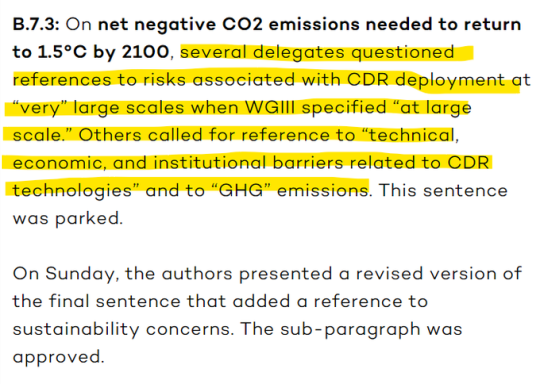

8.) Delegates from the poorest countries had mostly left by this point, leaving mainly rich countries and the richest economies in the global south to hash out the final wording of a document that will shape, to some degree, how habitable the planet remains for all humans.


9.) Saudi Arabia pushed back against a suggestion to replace "low-emissions technologies" with "zero-emissions technologies", and in the end both were accepted.


10.) The us pushed back on a suggestion from poorer countries' to specify their ability to cut pollution depends on what richer countries do with money, tech and the remaining carbon budget.

10.) China, Saudi Arabia, Egypt and Iran got rid of "taxes, subsidies and prices on consumption" as examples of tools to cut consumption-based emissions.
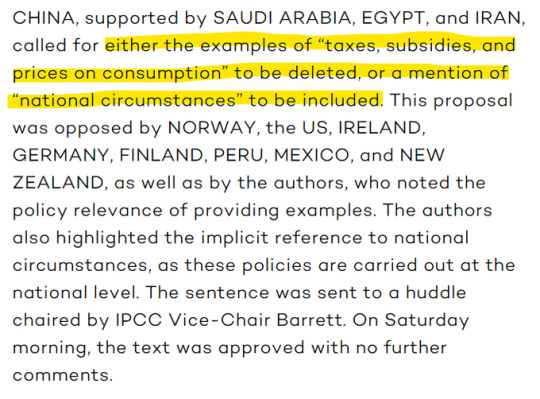

11.) The us unsuccessfully tried to delete the word "equitable" when discussing finance, arguing the word typically refers to each country getting the same share (in the context of climate diplomacy, at least, it does not.


12.) Switzerland and the U.S. tried to delete a sentence on climate finance gaps, arguing that there is no common definition of the words "climate finance", no IPCC definition of developing countries, and that the terms "gaps" and "opportunities" are unclear.
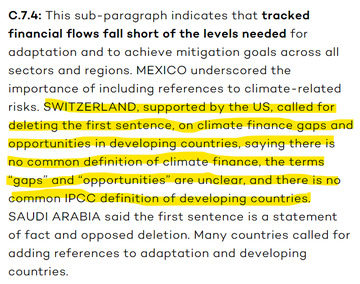
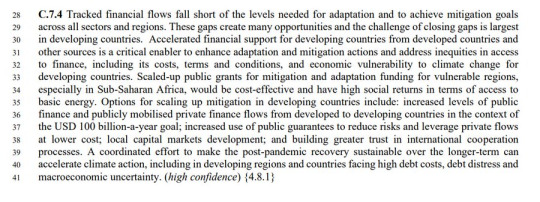
13.) The us blocked China's suggestion that richer countries are not transferring enough technology to poorer ones because of political and legal barriers.

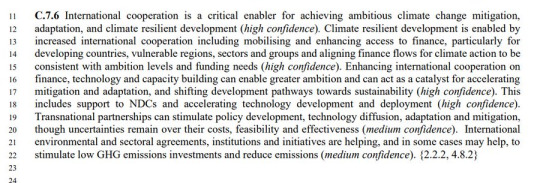
14.) The broader context: the approval session for this synthesis report should have been easier than previous ones because most of the text was taken or adapted from previously-approved summaries, but the report also means more to governments - and is more likely to influence how hot the planet gets - because it ties together all the IPCC installments from the last few years into a handy summary of summaries. So the stakes were higher, but the ability to lobby was weaker, and more compromises were made because so few people from the countries hit hardest by climate change could stay till the end.
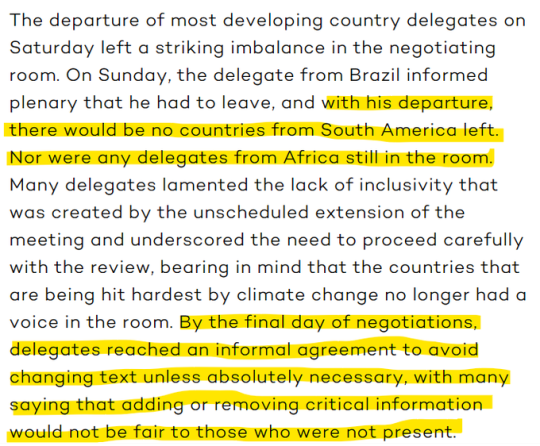
15.) We are left with a completely useless plan! My question: Why did IPCC open up to such 'negotiations'? It could have simply released the summary, as before! Every disaster movie starts with government officials ignoring warnings from scientists. That’s not coincidence. Pretty much the IPCC report is absolutely useless based on this thread. The media & politicians show no interest in what the original undoctored versions of this report actually look like. Does the report include the names of the negotiators for each country? NO. I would love to know who was carrying this water for the US.! I mean, objecting to the word “equitable”?!?!?! The unscheduled extension of the meeting meant that, by the time it finally ended, no-one from Africa or S. America was present, few from any less-developed countries at all were *in the room*...
16.) It is absolutely frightening to see that at this late stage most governments are still more interested in misleading and make-believing than doing anything real. We are going to 5 degrees. Push your politicians for massive CARBON PRICING or vote them out!
17.) Apparently aerosols were deliberately left out, because "INDIA called for deleting it"?! And adding the invaluable figure WG1 SPM.2 was "opposed by SAUDI ARABIA and INDIA" in a f*cking huddle?!
18.)https://twitter.com/Vaka_astra/status/1638623441569083392?s=20
19.)https://enb.iisd.org/58th-session-intergovernmental-panel-climate-change-ipcc-58-summary#brief-analysis-ipcc-58
0 notes
Text
‘Climate bomb ticking’, UN chief Guterres warns

The United Nations Secretary-General António Guterres said carbon emissions must be reduced by half before 2030 for the world to avoid a climate catastrophe, as he said “the climate bomb is ticking.”
Guterres said this on Monday in a recorded appearance before a UN Intergovernmental Panel on Climate Change (IPCC) where he also urged the developed nations to commit to achieving zero net emissions by 2040, Merco Press said.
The Portuguese diplomat also warned that “the rate of temperature increase over the last half-century is the highest in 2000 years. Carbon dioxide concentrations are at their highest in at least 2 million years. The climate time bomb is ticking.”
Guterres also launched “a survival guide for mankind” and said, “In short, our world needs climate action on all fronts: everything, everywhere, all at once.”
A report released on Monday summarised the findings of three expert assessments published between 2021 and 2022 that looked at the physical science, impacts, and mitigation of climate change.
The summary report is designed to provide clarity to policymakers as they consider additional actions to reduce emissions. The document was published after nine years of study by members of the IPCC.
The 37-page preliminary report was drawn from thousands of pages of previous assessments after a week of deliberations in Interlaken, Switzerland.
The 10,000-page study will also serve as a guide for a global inventory of climate change and individual state contributions that will take place this year at the COP28 climate summit. Under the 2015 Paris Agreement, nations are also expected to update their climate commitments by 2025.
“We have the tools to avoid and reduce the risks of the worst impacts of the climate crisis, but we must seize this moment to act now,” said US Climate Envoy John Kerry.
According to the IPCC, emissions must be halved by the mid-2030s if the world is to have any chance of limiting temperature rise to 1.5 degrees Celsius above pre-industrial levels, a key target enshrined in the Paris agreement.
“If we act now, we can still secure a sustainable livable future for all,” said IPCC Chairman Hoesung Lee.
On current trajectories, the planet is on track to warm by 3.2°C by the end of the century, and temperatures could still rise by at least 2.2°C even if existing commitments are met.
Average temperatures are already 1.1 °C higher than 1850-1900 levels, leading to more extreme weather events worldwide.
Read the full article
0 notes
Photo










International Tea Day
While everyone loves a cup of tea, many of the workers and producers of that tea face poor conditions and pay. Help raise awareness and keep tea fair.
The tea industry provides millions of people around the world with cups of tea in the morning. One of the biggest producers of tea, India, recognizes the importance of tea in its communities and as a commodity for commerce.
However, much of the working conditions for those within the tea industry still need much improvement. If you think this holiday was about drinking tea, well think again! International Tea Day is all about the tea workers and bringing civil rights into action. Let’s see how this holiday came to pass.
Do you love a good cup of tea? While International Tea Day can certainly involve paying homage to tea, we should pay homage to those working in the tea industry. The best way to do this is by helping to raise awareness regarding their working conditions so they can be improved.
History of International Tea Day
The International Tea Day campaign was launched in 2005 by the trade unions, small tea growers and civil society organizations in Asia and Africa to address the issues of living wages for workers and fair prices for small tea producers.
The International Tea Conference in New Delhi came out with an International Declaration on the rights of workers and small growers to help regulate uneven competition, land ownership, safety regulations, rights of women, social security and living wages. Another organization, The Tea Board of India, proposed International Tea Day in hopes of it becoming an official holiday to the UN Food and Agriculture Organization.
This was proposed by chairman Santosh Kumar Sarangi in 2015. According to the chairman, the proposal of India was supported by countries such as Canada, the United States, European Union, Sri Lanka, China, Japan, Kenya, and Malawi. While the holiday doesn’t have official status, the goal of this holiday is to recognize the vulnerable situations that tea producers in India have with current living conditions and worker-related policies.
The day also focuses on deliberating on urgent issues such as residues, climate change, technology and trends on production and consumption in the tea industry. To observe this day, over 150 representatives from tea organizations gather and conduct a seminar to discuss the pervading problems the tea industry has as well as problems faced within their own country.
International Tea Day Timeline
2737 BC Tea is discovered as a beverage
Legend has it that Chinese Emperor Shen Nung is sitting beneath a tea tree while a servant boiled water for drinking. Some leaves fall into the cup and begin the practice of drinking what is now called “tea”.
1610 Tea comes to Europe
It is believed that the Dutch were the first to bring tea to Europe, just a few years prior to the introduction of coffee by Venetians.
1773 The Boston Tea Party occurs
With the intention of revolting against the high taxes levied by the British government without providing any voice, residents of Massachusetts throw tea into the Boston Harbor. “No taxation without representation” is the major complaint.
2004 International Tea Day is created
At the World Social Forum, International Tea Day is conceived and then celebrated the following years in New Delhi and Sri Lanka, then later in other tea-producing places like Nepal, Viet Nam, Bangladesh and others.
2019 United Nations adopts International Tea Day
After some years of advocating for its observance, International Tea Day is adopted by the United Nations General Assembly at the suggestion of the FAO Intergovernmental Group on Tea.
How to Celebrate International Tea Day
If you’re a lover of tea, then do some research about some of your favorite companies. Try looking up tea brands that support fair trade, and possibly switch to those brands to make a difference in the way you buy products such as tea. Use the hashtag #internationalteaday to help recognize it as an official holiday and educate others about the tea industry if you’re interested.
You could also use International Tea Day to try a variety of tea you have never had before. Matcha, for example, is highly popular as of late. You need to shop with care, though! The first thing you need to take a look at is how the Matcha has been produced and sourced.
You need to ensure that all veins and stalks have been removed so that there is not any bitterness and only the finest leaves should be used. Secondly, the color of the matcha powder is a significant factor. The greener the color is, the better. This is because the leaves are forced to overproduce chlorophyll because Matcha is shade-grown, which causes the vibrant green shade.
If the Matcha is yellow or brown in color, this is a sign that the leaves have not been properly shaded or that branches and stalks have been included. The price is the third factor to consider. Like most things, if you want quality, you can expect to pay a little bit more.
If something seems too good to be true, the chances are that it is. The feel of Matcha is also important. It should be a fine powder that is very silky. Last but not least, the taste is obviously a crucial attribute when it comes to quality. It should have a clean and naturally sweet taste.
Why not make some delicious baked green tea treats on International Tea Day and have a bake sale to raise money and awareness regarding working conditions in the tea industry? Green tea recipes are available in their abundance. People are actively searching for different ways to enjoy green tea. While green tea is delicious when simply mixed with hot water, there is nothing wrong with switching it up from time to time, especially on International Tea Day!
An easy and delicious recipe is Matcha Meringue Kisses. To make this you will need Matcha, sugar, egg whites, and powdered sugar. Begin by sifting together the Matcha and the powder sugar, and then whip the egg whites until they have soft peaks. Gradually add the sugar and whip until stiff peaks. Gently fold the Matcha into this mixture and then transfer to a pastry bag. Pipe the mixture into small kisses onto a baking tray and then bake for around an hour.
Or, why not make Green Tea Donuts? For this, you need green tea, honey, melted butter, milk, egg, salt, baking powder, sugar, and cake flour. You whisk the green tea, salt, baking powder, sugar, and flour. Add the honey, melted butter, milk, and egg, and then whisk. Use a pastry bag to pipe the batter into the mould. Then, simply bake the donuts for eight minutes. You can make your own glaze to go on the top – chocolate goes well!
Other delicious baked treats to try include green tea muffins, brownies and shortbread!
International Tea Day FAQs
What is International Tea Day?
Created to celebrate and pay tribute to the countries that produce tea to supply to the world, starting in India and moving to other places like Sri Lanka, Malawi, Uganda, Bangladesh, Vietnam and more.
When was International Tea Day first celebrated?
International Tea Day first got its start in 2004 when it was celebrated in New Delhi. It grew over the years and by 2019 the day was adopted by the United Nations General Assembly.
How to celebrate International Tea Day?
A great way to observe this day is by learning a bit more about the nations who produce tea for the world. Also, don’t forget to order a cup of fair trade tea for one, or take a friend out to enjoy a cuppa together.
What is the theme of International Tea Day?
The theme for this day devoted to tea producers changes each year, but some of the past themes have included themes such as Tea and Fair Trade or Harnessing Benefits for All from Field to Cup.
When is International Tea Day celebrated?
Taking place on May 21 of each year, International Tea Day originally took place on December 15 from 2005 when it was often only celebrated by tea-producing countries. It changed to May 21 when the UN adopted the day.
Source
#Earl Grey#Earl Grey Tea is my favorite tea#Computer tea Earl Grey hot#USA#I don't like coffee#I only drink tea#original photography#always unsweetened#Lemon Black Tea Lemonade#Tropical Ice Tea#Peach Green Tea#Lavender Ice Tea#Pineapple Black Tea#Strawberry White Tea#Peach Citrus Green Tea#International Tea Day#21 May#InternationalTeaDay#travel#vacation#Capilé#Portugal
3 notes
·
View notes
Text
Message Hollydays Dear UN DESA Voice Readers,
We hope that this message finds you and yours well and safe.
As 2022 is about to come full circle, we look back at yet another turbulent year for the global community. War, conflict, growing inequalities, rising poverty and hunger, along with hardships following the COVID-19 pandemic; these are just some of the adversities that the world is battling at this moment in time.
Amidst these intensified global crises, UN DESA has continued to champion the 17 Sustainable Development Goals (SDGs). These goals are our blueprint to achieve a better world, for everyone, everywhere, and the need to implement them has become more urgent than ever.
Guided by UN DESA’s plan of action, the Department has continued to address poverty and the root causes of inequality, steered global action on the SDGs, ensured sustainable financing, made data count, protected our planet, and placed sustained efforts at framing the future of development.
Through our roles to support intergovernmental processes, we have continued to help shape deliberations that stressed solidarity and a just, inclusive, and sustainable response and recovery to the crises.
UN DESA has moreover played a critical role in efforts to save our ocean, leading the coordination of the major UN Ocean Conference, which took place in the Portuguese capital of Lisbon in June. Our commitment to ensure that climate and SDG action go hand in hand also remain steadfast, with our SDG Pavilion at COP27 seeing a record number of events and visitors engaging in the space.
The Department also predicted a landmark moment on 15 November – the Day of 8 Billion People -- when our world became 8 billion strong. A historic milestone which UN DESA highlighted together with the UN Population Fund (UNFPA) through a number of events and an online campaign.
We also continued to share our data, analysis and recommendations with a global audience, through the Global Policy Dialogue Series, and our UN DESA Policy Briefs, which has been addressing some of the most pressing issues facing policymakers worldwide.
You can learn more about UN DESA’s efforts to promote and advance the long-term goal of shared prosperity on a healthy planet in UN DESA’s Annual Highlights Report 2021-2022.
As we close the chapter on 2022, we would like to take this opportunity to convey our warm thanks to you for your continued loyal readership and for following and supporting UN DESA’s work. We are honored, grateful and proud to have you with us and look forward to continuing our journey to deliver sustainable development for all.
We wish you all Happy Holidays and a Happy New Year! Stay well and safe!
With best wishes from
the UN DESA Voice Editorial Team
0 notes
Text
Erdogan attends European Political Group summit in Prague
President Recep Tayyip Erdogan has represented Türkiye on the
first summit of the newly established European Political Group
in Prague on Oct. 6 and was scheduled to carry bilateral conferences
with distinguished world leaders together with French President Emmanuel
Macron, President of EU Fee Ursula von der Leyen in addition to
Armenian Prime Minister Nikol Pashinyan, Pattern stories citing
Day by day
Information.
Erdogan led an enormous delegation in Prague that included Overseas
Minister Mevlut Cavusoglu, presidential advisor İbrahim Kalın, the
head of the Communication Directorate Fahrettin Altun in addition to
particular envoy for the normalization with Armenia Serdar Kılıch.
Previous to bilateral conferences, Erdogan met along with
Azerbaijan President İlham Aliyev and Pashinyan.
Within the format of an intergovernmental assembly, all of the international locations
are represented equally and no last communiqué was deliberate to be
issued after the summit. Erdogan attended the opening session and a
spherical desk assembly dedicated to peace and stability in Europe and
was scheduled to attend the closing dinner hosted by Czech
management.
Originally published at Irvine News HQ
0 notes
Link
This quote from the story, from a staffer of Friends of the Earth, is, unfortunately, expressing my emerging thoughts about President Biden: “The honeymoon’s over. It’s now September, they’ve been in office for eight months. It’s time for them to show that they have priorities and are meaningfully going to move in the right direction.” I like him, but I’m not liking his environmental and climate policies. It’s almost as if he wants them to fail, so he can tell the environmental and climate science constituents and supporters: see, I tried, but you’re asking too much. I want to be proven wrong about that.
I’ve been arguing, mostly with myself, that the resumption of the offshore leasing program, after President Biden suspended the program, is being done pursuant to a court order to do so. Perhaps, but that court order doesn’t impede a deliberate, thoughtful approach to each lease offer, with appropriate environmental research (which includes climate). And the Department of the Interior appealed the court order. But this stiff arm from the Bureau of Ocean and Energy Management is wildly out of line with what President Biden says he’s aiming to do.
Excerpt from this story from Truthout:
As the Biden administration pushes forward with plans to expand offshore drilling in the Gulf of Mexico, officials have argued that alarming research presented in the recent Intergovernmental Panel on Climate Change (IPCC) report isn’t sufficient to pause or reassess drilling plans.
As first reported by The Daily Poster, the Bureau of Ocean and Energy Management (BOEM) wrote in a recent document that the IPCC report “does not present sufficient cause” for the agency to take a second look at the administration’s plan to continue issuing leases for drilling.
The Bureau instead opens the door to future fossil fuel development projects. “The report, as well as additional analysis of climate change, may be a significant consideration in the Department’s decisions regarding oil and gas leasing programs in the future,” officials wrote.
Climate advocates were frustrated with the agency’s callous regard toward the IPCC report and the decision to march ahead with the leasing.“The honeymoon’s over,” between climate groups and the Biden administration, Friends of the Earth deputy legal director Hallie Templeton told The Daily Poster. “It’s now September, they’ve been in office for eight months. It’s time for them to show that they have priorities and are meaningfully going to move in the right direction.”
In the BOEM’s document, the administration argues that officials must comply with a court order that requires them to lease about 80 million acres of the Gulf of Mexico for fossil fuel projects.The court order was a product of a lawsuit by states that are led by fossil fuel-funded Republicans; earlier this year, they sued the administration over an order that would have blocked the sale.
Climate advocates argue that the Biden administration has the power to decide whether or not to hold land sales for drilling. Earthjustice, on behalf of Friends of the Earth, Sierra Club, Healthy Gulf and the Center for Biological Diversity filed a lawsuit at the end of August arguing that given the urgency of the climate crisis, the lease sale cannot go forward.
39 notes
·
View notes